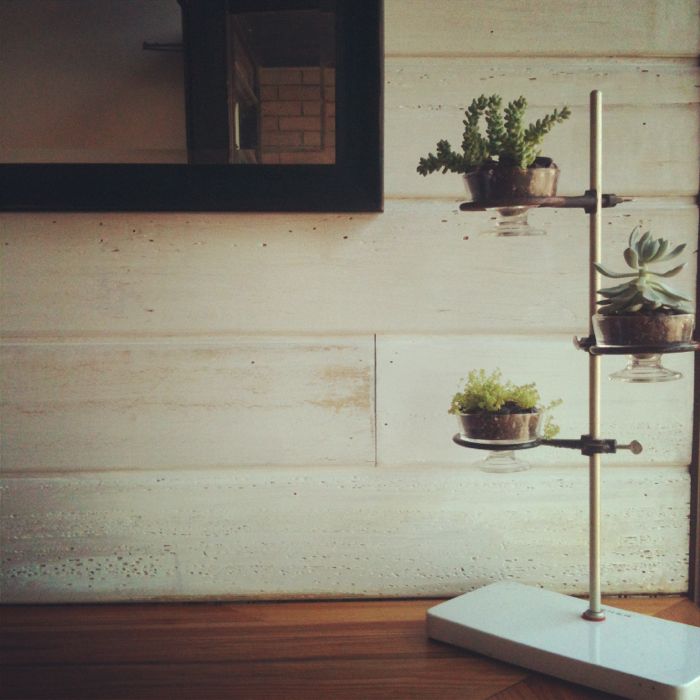Whitewashing Wood Paneling for a Natural Modern Look

Whitewashed horizontal wood walls at Little Freshie in Kansas City
Perhaps I am drawing inspiration from our current snowy outdoor landscape which is white as far as the eye can see, because today is all about whitewashing.
What is whitewashing?
White washing is the process of painting unfinished wood with a diluted paint solution so that the grain shows through. Traditionally, this was done with some sort of crazy chemical lime solution, but in this blog post, we are only focusing on paint and stain.
Why whitewash?
Whitewashing lends a softer, more natural look than a hard white coat of paint. It has lately been associated with cottage or shabby-chic style furniture; however, when applied to larger elements of a room, it can feel rustic and natural.
How do you whitewash wood?
It depends! There are many different types of wood with different existing coatings and finishes. There are several techniques, and it is always best to test a swatch piece before starting your project. If you don’t have a test piece, try your technique in a dark corner or behind a door – somewhere inconspicuous. Many tutorials advise to buy regular white paint and thin it down with one, two, or three parts water. Alternatively, your wood may soak up normal white paint so much that one normal coat will provide a whitewashed look. White stains are also available. Another technique is to rub/brush in the whitewash stain or diluted paint mix, let it sit for a couple of minutes, then wipe off the excess.
Can I whitewash paneling that has previously been finished, lacquered, urethaned or stained, or sealed?
No. Your wood has to be unfinished to achieve this natural whitewashed look. However, you can experiment. If the paneling is stained, but not sealed, then the stain may discolor your white paint and look terrible. If the paneling is sealed, then you will not be able to penetrate the grain; however, you can try a thinned coat of white paint and see if you like the effect. Whether you make it thin or opaque, your new coat of paint will just sit on top of the original finish. Chances are, you will end up with paneling that just looks poorly painted. A couple solutions could be to flip the boards over to an unfinished side or sand the panels down to the bare unfinished wood before beginning your work.
My Whitewash Project
Soon, Mistersnodgrass and I will attempt to whitewash the exposed (unfinished) basement ceiling in our 1939 Cape Cod home. I believe the type of wood is oak, and because of its beautiful rich grain, I think it is the perfect specimen for whitewashing. We are going to test our technique in the unfinished part of the basement ceiling first, and I think we will start with diluted paint as this seems the cheapest and easiest option. If that doesn’t look pretty, then I might try a sample of the Minwax whitewash/pickling stain and see if it looks better. Have you whitewashed anything before? I would love to hear about your experience.
*These resources were helpful to me in researching this project:*
Sarah Richardson Design, “Paint it Whitewash”
DIY Network, “Whitewashing and Pickling Techniques“







Sarah,
Really like this post about whitewashing wood. It is a technique I hope to try soon. I am always looking for creative backgrounds to use in my photography. I would like to see an article on how to create other types of textures, like stucco or the distressed look, for instance. I also posted your article on my blog.
Thanks and have a great day.
So how did it turn out? I am between using thinned white paint vs Minwax pickling stain. I’d love to hear your feedback. Thanks!
I used 2 parts white latex ceiling paint to 1 part water to paint my son’s loft bed that my husband built out of 2x4s. It softened the yellow look of the wood, and looks beautiful. I investigated buying the pickling/whitewash product from Miniwax, but the price was around $11. I knew I had plenty of white paint laying around. I’ve decided to also do his bedroom door in a whitewash as it’s still unstained/unpainted. In our living room we have diagonal, yes diagonal wood paneling that is the bane of my existence. Now I’m considering white washing that as well!
Would love to know how this turned out as i have diagonal finished pine planks going up my stairs and was not planning on sanding [too messy] but wanted to white wash. Thought maybe chalk paint to eliminate prep
Can you please come and help me white wash my dark wood paneling in my attic